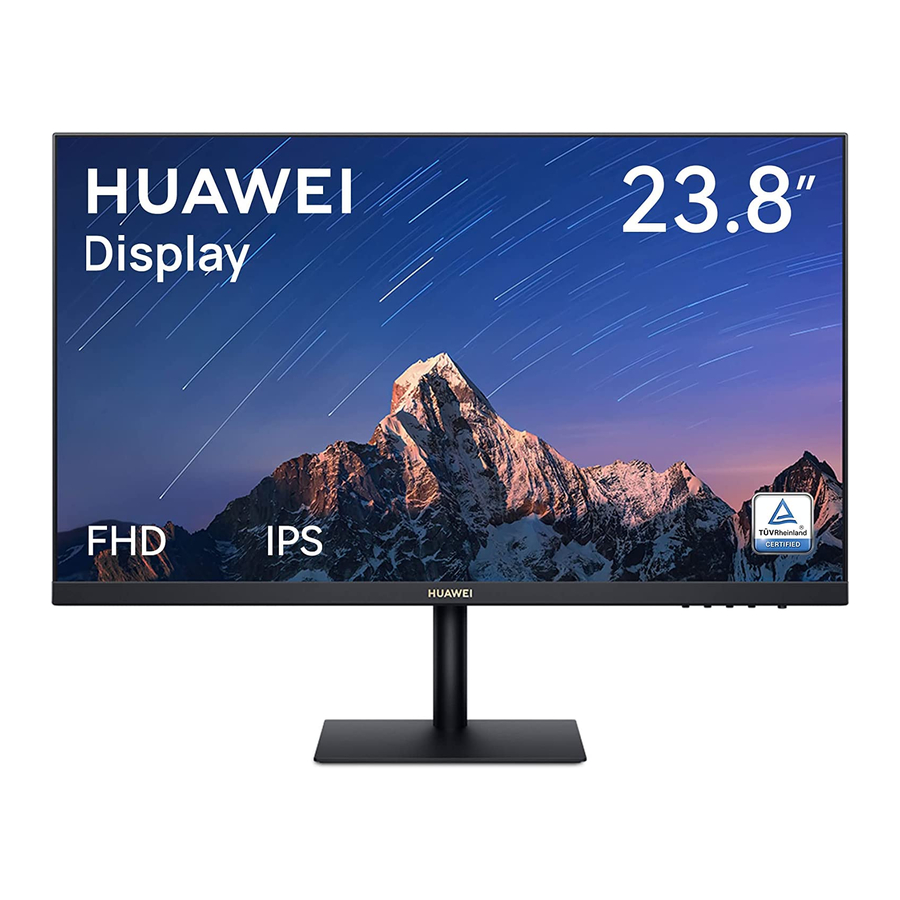Advertisement

About this guide
This document only applies to associated devices. Read this document carefully before using the device.
The components listed in this document may not be included in the device. In this case, you will need to purchase them separately. The functions described in this document can only be used when they are used together with other components. The figures and UIs in this document may be different from the actual ones. All figures are for reference only.
Symbols and definitions


Appearance

| 1 | Panel |
| 2 | Support |
| 3 | Base |
| 4 | Function buttons Adjusts the display settings. For details, see the Configuring the display section. |
| 5 | Power button/Power indicator Turns the display on and off.
|
| 6 | Power port Connects the power adapter for turning on the display. |
| 7 | HDMI port Connects to an HDMI input device, such as a tower. |
| 8 | VGA port Connects to a VGA input device, such as a tower. |
Installing the display


- Place the display panel on a clean and flat surface, with the front side facing down. (You can view device information including the S/N code on the nameplate on the rear side of the display panel.)
- Use screws to connect the base to the support.
- Tilt and insert the upper end of the base support into the slot at the rear of the display, and then press the base support downwards until you hear a clicking sound, which indicates that the base support has been installed correctly.
To remove the base, find the button above the port at the rear of the display, push the button upwards, lift the bottom of the base support, and remove the base.
Connects the display to the tower

- Gently lift the assembled display and place it on a flat surface.
- Use an HDMI or VGA cable to connect the display to the computer.
- Connect the power cable to the display and connect the power supply.
- Power on the tower and display. If images are displayed on the display, it indicates that the installation is successful. If no image is displayed on the display, see the FAQs chapter.
- Adjust the pitch angle of the display as required.

Configuring the display

After the display and the tower are assembled and powered on, the system automatically configures and optimises the settings of the display. If you need to configure the display settings, you can also open the settings menu of the display to adjust the settings.
- Press any button from 1 to 4 to access the display settings menu.
- On the settings menu screen, press buttons 1 to 4 to set the parameters.
| 1 |  | Exit/Back |
| 2 |  | Downward/Leftward adjustment |
| 3 |  | Upward/Rightward adjustment |
| 4 |  | Confirm |
The default language of the display is English. You can change the language in More settings > Language, as well as configure other settings.

Functions in the Settings menu
 | Adjusts specifications such as screen brightness and contrast. |
 | Selects a video input signal. |
 | Switches between different colour temperature modes including low blue light mode or cool mode. When reading for a long time, we recommend that you set the screen colour temperature to low blue light mode to prevent eye fatigue and make it easier on your eyes. Once Blue light mode is enabled, the screen will take on a mild yellow tint. When reading for a long time, we recommend that you set the screen colour temperature to low blue light mode to prevent eye fatigue and make it easier on your eyes. Once Blue light mode is enabled, the screen will take on a mild yellow tint. |
 | Adjusts the display settings such as the display mode. |
 | Selects the display scenario. |
 | More settings, such as language, menu transparency, and reset settings. |
FAQs
Unable to power on the display
- Check whether the display is powered on.
- Check whether the power adapter is correctly connected to the display and the power supply.
There are no images on the display
- Check whether all of the cables are correctly connected.
- Check whether the display and the tower are powered on.
- Check whether the VGA or HDMI signal cable is damaged.
- If the preceding issues do not occur, restart the display and the tower, then check whether the images can be properly displayed on the screen.
The screen is too dark or too bright
- Open the settings menu on the display and adjust the screen brightness and contrast.
- If the keyboard comes with the
![]() and
and ![]() keys, you can use them to adjust the screen brightness.
keys, you can use them to adjust the screen brightness.
The screen colour is abnormal
- Check whether the VGA or HDMI signal cable is damaged. For example, the pins may be bent.
- Open the settings menu on the display and adjust the colour temperature.

Documents / ResourcesDownload manual
Here you can download full pdf version of manual, it may contain additional safety instructions, warranty information, FCC rules, etc.
Advertisement
Thank you! Your question has been received!














Need Assistance?
Do you have a question about the Display 23.8 that isn't answered in the manual? Leave your question here.